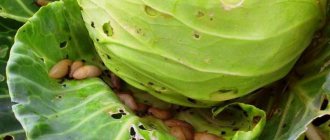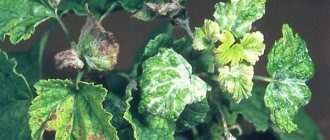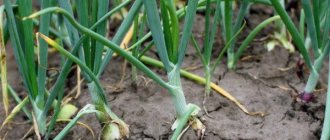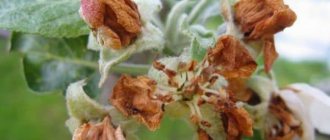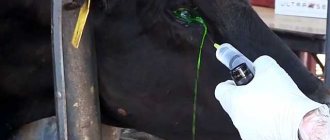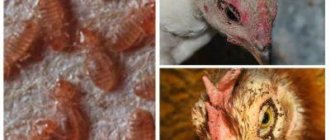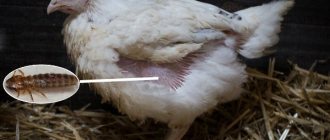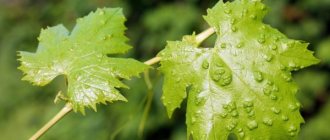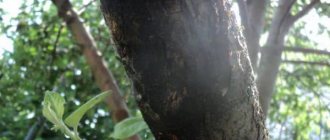Popular insecticides
- before processing, it is better to take the flower pot out onto the balcony or loggia;
- processing is carried out with gloves and glasses. A respirator is required!
"Aktellik"
This is a fairly effective remedy. They spray it on indoor plants and water the soil in pots. Can be used for treating garden crops and storage facilities (including barns).
1.5-2 ml of the product is dissolved in one liter of water. The resulting solution is sprayed onto the entire plant. The remains can be poured into the soil, under the roots.
Affects insects over a period of several minutes to several hours. The speed of action is determined by the state of the insect and the air temperature.
Protection lasts up to three weeks. Warehouses can be processed once every eight months.
- prevents the reappearance of pests;
- there is no addiction in insects;
- can be mixed with other insecticides to achieve maximum effect;
- seed treatment is permissible (for prevention).
- unpleasant odor;
- dangerous for pets and children;
- not recommended for residential use.
"Aktara"
It is used to combat various types of pests. The product can be sprayed on plants or injected directly into the soil.
For indoor plants, 0.5-1 ml of the product from a bottle (9 ml) is dissolved in one liter of water. It is best to pour the solution into the soil. Then the poison will permeate all the leaves and destroy the scale insect.
Treatment of trees and plants in open ground is carried out using a sprayer.
First, one sachet of dry insecticide (4 g) is diluted in 1 liter of water. The resulting milk is diluted with water in the sprayer tank. For a quarter tank of water you will need 600 ml of flower treatment product, 250 ml for currants and trees.
The pests die within a day.
- efficiency;
- can be used with growth stimulants;
- not addictive.
- unpleasant odor;
- the product is toxic to bees;
- Treatment cannot be carried out in a residential area.
"Bankol"
It is used for spraying both indoor plants and gardens.
Has a contact effect. Damage to the nervous system and paralysis in pests occurs within one to two days.
In floriculture, a solution of 0.5-0.7 g per liter of water is used.
Advantages:
- low toxicity to humans and animals;
- is poorly washed off from plants by rain;
- it is permissible to combine with growth stimulants;
- has no smell.
- most effective at high air temperatures;
- not used for garden treatment.
"Bitoxibacillin"
In addition to the insecticide, it contains bacterial
complex. Acts on pests through intestinal damage. Within a day the insects cannot feed. Three days later, their mass death begins.
35 ml of product dissolves in 5 liters of water. You can treat indoor plants and trees.
- repeated processing is required;
- efficiency in open ground depends on the ambient temperature (permissible minimum +18 degrees);
- cannot be used without personal protective equipment.
The nodule weevil can eat up to two square meters in one day. cm greenery. Read here how to deal with this pest.
The fat fir leafroller is slightly larger than other types of leafrollers. You will find a detailed description of this insect in the article at https://stopvreditel.ru/rastenij/lesov/listovertka.html link.
Scale insect pest on indoor plants: how to fight
The scale insect appears on flowers with purchased plants, cut flowers near potted ones, after airing.
Photo of a pest on different indoor plants
Methods for getting rid of scale insects on an orchid are:
- insulating the plant, increasing air humidity and daily ventilation of the room;
- washing with warm water to remove larvae;
- eliminating ants (wet cleaning with vinegar added to a bucket).
Folk methods of wrestling are:
- denatured alcohol (10 mg of a substance containing alcohol) and liquid soap (15 mg), which are applied to the pest;
- olive oil (2 tbsp per 1 liter of water);
- garlic cut;
- fern decoction (10 g dry or 100 g fresh) boiled for half an hour is used for a week.
The mixture must be applied with a brush or spray. Alcohol solutions are used exclusively on damaged areas.
Scale insects on ficus can also be eliminated manually by washing with a soapy solution and removing infected leaves and twigs. This eliminates infection at the initial stage. Next, you should act with fungicides and insect predators. Pesticides and pepper, garlic and onion infusions have a destructive effect on young pests.
The scale insect pest spreads faster on house plants if the owner, trying to help the cultivated plant, uses growth regulators and especially nitrogen-containing fertilizers.
Brief description of the pest
Scale insects (Latin name – Diaspididae) are a family of insects found throughout the world. They are known as pests of wild, cultivated and ornamental plants, causing great damage to gardening. Science lists 2,400 species among them, of which the plum, comma-shaped and Californian scale insects most often infect plums. The latter, despite its foreign name, is widespread in Russia, Ukraine, Moldova and other neighboring countries.
Insects reproduce by laying eggs. Soon larvae emerge from them, and then adults. They are characterized by pronounced sexual dimorphism: females are very different from males both in appearance and in the characteristics of their life:
- The body of females is protected by a hard shell - a rounded shield, reaching a diameter of up to several mm. Its color depends on the species and age of the individual. She has no legs, whiskers, wings or even eyes. The female scale insect spends her entire life in one place, clinging to a plum shoot.
- The male looks completely different: he is a small winged midge with antennae, legs and eyes colored purple-red. The male individual circles around the plants, but does not cause them any harm: only females and larvae feed on plant juices.
- The larvae molt several times, gradually becoming similar to adults. They need nutrients to grow, and they suck them from plum shoots. Starting from the second instar of the larva, the male sex appears divided into a head, chest and wing rudiments. Female individuals become overgrown with a dense shield, and their wings and eyes are also reduced.
Scale insects are visually similar to growths on the bark of a plum tree. They live mainly in colonies consisting of insects that differ in age. Single individuals are extremely rare.
Scale insects and its types
The peculiarity of this insect is manifested in the presence of a protective shield consisting of the remains of the larvae’s scales, glued together with its secretions. Externally, such a shell is very similar to irregularities in the surface of tree bark, which makes visual detection of the pest difficult.
The size of the insect does not exceed 5 mm, its main activity is sucking juices from plants, so it is necessary to fight scale insects in the garden, otherwise, when it multiplies en masse, the bark, fruits and ovaries on the tree will be covered with scatterings of these pests. Insects also secrete honeydew, which becomes a breeding ground for sooty fungi, causing the affected plants to gradually dry out and die.
Signs of a scale insect settlement:
- yellow spots appear on the leaves, then they turn yellow completely, curl and fall from the branches;
- the bark cracks, thin and thicker branches begin to fall off;
- the growth of the tree is inhibited, which can lead to its complete drying out and death.
Weakened trees are most susceptible to scale infestation; their appearance is also affected by excess nitrogen fertilizers, insufficient lighting of plants, lack of moisture, and dry air.
Types of scale insects In dacha and garden plots in central Russia you can find several types of scale insects:
- Californian - affects fruit trees: apple, peach, plum, etc. On pear branches, the scale insect looks like small dots with colored dots or a rim.
- Comma-shaped - has a white body, similar in shape to a comma, looks like a growth on the bark of a tree up to 4 mm in size, on top of the female there is a light brown shield. During reproduction, the female lays up to 100 eggs and dies, and the nest, covered with a protective shell, winters safely even in frosts down to -30˚C. In the spring, young “vagrants” of yellow color, microscopic in size, about 0.3 mm, quickly move along the tree trunk in search of food, at this moment they are easiest to detect. Then they stick to a certain place on the bark and “grow” to it, throwing off their legs.
- Willow false shield - differs from other species in its wide and flat shell of white or gray color, size 1.8-2.5 mm. Females have a yellow-red body and lay purple-red eggs. The willow scale insect settles on currants, raspberries, gooseberries, as well as willow, bird cherry, aspen and other trees.
Types of garden scale insects
There are a huge number of species of scale insects known - about 2,500. The vast majority of them infect plants that are grown indoors or in greenhouses. Plants growing in open ground are threatened by only a few species of scale insects. Read also the article: → “Ways to combat scale insects in the garden, tips for treating trees.”
This photo shows a close-up of the Californian scale insect.
There are several types of scale insects:
| Name | Description of females | Description of males | Signs of defeat |
| Californian | The shields are round in shape. Color – gray, sometimes brownish. Body up to 0.2 cm long, flat, lemon-colored. | The shells are grayish, oval in shape. Their size is 1 mm. The body of males is light orange. | First, oblong cracks appear on the branches and trunk. Then cracks located in the transverse direction are added to them. Red spots form on the fruits and leaves. They merge over time. 2-3 years after infection, young plants die. |
| mulberry | The size of females is 0.2 cm. The scutellum is rounded, white, less often gray. The body is light orange or yellow in color. | Males have an oblong white shield, on which there is a pair of longitudinal grooves. The body of adult males is approximately 1 mm long and yellow in color. They have a pair of wings, legs, and antennae. | The plant weakens, the fruits appear much smaller in size. Due to the appearance of stains, they become unsuitable for food and sale. |
| Purple | Females are 1 mm long. Their body is oval, almost pentagonal in shape, and purple in color. The scutellum is white, up to 2 mm in size. | Males are winged and reddish-violet in color. Their size is approximately 1 mm. The scutellum is whitish in color, flat in shape, smaller in size than the body. | Affects terrestrial plant organs. The pest can be noticed first along the main vein of the leaves and on the stalk. After the insect appears, the leaves begin to discolor. The fruits lose their commercial quality due to the appearance of purple-red spots on them. |
| Comma apple | The body itself is less than 1 mm in size and has a pear-shaped shape. The scutellum is oblong, brown. | Males are winged. At the top of the abdomen they have a long process. The color of males is reddish-gray. | Infestation is indicated by spots that appear in the places where the pest has settled. |
| Oyster | The body is short oval. May have a lemon or greenish-yellow color. The color of the scutellum is grayish-olive. The shape is slightly flattened in the central part. | Males are winged - yellowish-orange. They have a black band on their back. The scutellum is about 1 mm in size, short-oval. | They usually affect leaves, branches, and trunks, located on their undersides. Fruits are rarely affected. |
Warning before destroying scale insects
Before you destroy the scale insect, take care of your own safety. If you choose to use chemical sprays, you should take care to protect yourself with covered clothing and protective equipment such as gloves, safety glasses, and a mask (or respirator).
When using any chemicals or insecticides, be sure to read the label - this is very important for your health and the environment. After applying any chemicals or pesticides, make sure you wash all exposed skin thoroughly with soap and water.
It is better to clean and dry clothes outside the home, for example in the garage
After applying any chemicals or pesticides, be sure to thoroughly wash all exposed skin with soap and water. It is better to clean and dry clothes outside the home, for example in the garage.
Pest control measures
It is difficult to fight scale insects, since they multiply quite quickly, and the shell-like shield protects it from the effects of pesticides. All used control methods can be divided into groups.
- Mechanical. At an early stage of infection or if the plant is small, the affected branches or branches should be removed (followed by burning them). You can try to wipe insects off the leaves with a soapy sponge or a swab soaked in alcohol.
- Folk. In the fight against scale insects, folk remedies do not give good results. You can try spraying with a mixture of machine oil and soapy water (1:10); carry out the procedure at least three times every 10 days. Various herbal infusions are also used: onion, garlic, pepper, fern, tobacco, celandine, walnut. A mixture of 1% pine concentrate with a 0.5% solution of laundry soap and a 0.2% salt solution is effective against young larvae (vagrants).
- Biological. Entomophages (for example, blastotrix and others) can be used against scale insects. Mulberry scale and false scale insects are especially sensitive to biological agents. Biological methods also include fungicides based on fungi (avertin, aversectin) and pathogenic nematodes (nemabact). These drugs can be successfully used in the fight against Californian scale insects.
- Chemical. Unfortunately, such an insidious pest as scale insects cannot be dealt with without pesticides. But even when using potent insecticides, it is necessary to take into account the development cycle of these insects. Since the shell is quite good protection, the most vulnerable are young wandering larvae.
The first stage of the fight should be carried out in early spring (before the buds open). This will help get rid of overwintering larvae. During this period, the plants are sprayed with nitrophen, karbofos, preparation No. 30, oleocuprite, and dnok.
When sprayed with oily emulsions, a film is formed that deprives the scale insect of access to air, and also, flowing under the shield, poisons the insect.
In case of severe infection, the plant should be sprayed again immediately after flowering with karbofos, actellik, rovikurt or rogor. The preparation Aktar gives good results; it can be used to spray the plant itself and the soil underneath it. In June, the treatment should be repeated, since at this time the Californian scale insect produces second-generation larvae. And if infected with mulberry scale insects, treatment must be carried out in September.
The dosage of pesticides is always indicated on the packaging and must be observed.
And since they are all quite toxic, do not forget about caution and personal protective equipment
The scale insect is a very insidious enemy, the fight against it is always long and difficult. But now you know how to get rid of scale insects in the garden. By treating the plants correctly and in a timely manner, you can cope with 90% of these pests. Then be patient, arm yourself with our advice and don’t give up. You will definitely be a winner!
Fighting Californian scale insects in the garden
If timely measures are not taken to combat Californian scale insects, which damage many fruit trees and shrubs, you can lose the harvest, and in the most advanced cases, the plants themselves.
The fact is that the bark of damaged trees cracks, first thin and then skeletal branches die.
The fight against scale insects should begin in the spring, before the sap begins to flow in the trees, while there is still an opportunity to completely exterminate the pest.
What does the scale insect look like in the photo and how to deal with the pest in the garden
Photos of scale insects and measures to combat them are for your attention on this page:
The California scale insect is a dangerous pest of horticultural crops, damaging many trees and shrubs (apple, pear, apricot, peach, cherry, plum, hawthorn, quince, rose, lilac and other plants).
An inexperienced gardener, knowing about the need to combat scale insects in the garden, can detect these worst pests on apple and pear fruits in the form of small dots with a bright rim around them. These are summer wanderers, and the bulk of the pest is on the bark of trunks, skeletal branches and young shoots in the form of a gray-white solid coating that is easily cleaned off with a fingernail.
Many people, not knowing what the scale insect looks like, think that it is a rather large insect under a brown, convex, clearly visible shield. In fact, this pest is very small, but the damage it causes to plantings is very large.
In damaged trees, the bark cracks and falls off, leaves fall off prematurely, and thin and then individual skeletal branches die. Red spots on fruits sharply reduce their quality, they become smaller, do not gain sugar content, wither and fall off prematurely.
Look at the photo what a scale insect looks like - the female pest’s body is round, lemon-yellow in color, covered with a round shield, the size of which is 1.5-2 mm (that’s why they are so difficult to see):
Females are viviparous. Maximum fertility is 130-140 larvae. The larvae are flat, oval, yellowish-lemon. The hatched larvae (vagrants) lead an active lifestyle and move throughout the plant.
Then the wanderers, sticking their proboscis, attach to the plant and begin to secrete white waxy threads, from which a white shield is formed that covers their body. Soon the shield becomes light gray, then dark gray. On the 10-12th day after suction, molting occurs and the pest’s body increases in size.
The larval skin is attached to the bottom in the center of the scutellum, and the larva enters the second instar.
The scale insect overwinters in the stage of first instar larvae, but in warm winters second instar larvae and adult females are found. Overwintering larvae have a dense black shield.
The awakening of the wintering generation in the spring begins with the beginning of sap flow in the trees. Therefore, the first methods of combating scale insects should be taken already at this stage.
Colonies of these insects are especially numerous in neglected, unkempt gardens. Where effective methods of controlling California scale insects and other pests (leaf rollers, codling moths, aphids) are not used.
Means and methods of combating Californian scale insects on trees
How to fight scale insects in your garden using effective drugs?
When these insects appear in the garden during the mass hatching of vagrants (mid-June and mid-August), spray the infested trees with one of the insecticides.
Good means for combating scale insects are “Aliot”, “Kinmiks”, “Iskra-M”, “Fufanon”, “Inta-VIR”.
The number of scale insects is also reduced by spring spraying of fruit trees against leaf rollers and weevils (the last ten days of April); at this time the scale insects molt, but the preparations are the same.
Solutions of pesticides should hit the plants in the form of tiny splashes - sprayed.
They must be applied evenly not only to the top, but also to the underside of the sheet.
To achieve high spraying efficiency, you need to ensure that the entire tree and especially the cracks in its bark are well moistened with the solution.
Another effective method of combating scale insects on trees:
The article has been read 23540 times.
California scale insect
Finding the scale insect itself on an apple tree is not so easy.
After all, its size is only 1.5-2 mm. However, this inconspicuous insect is considered a leader among pests of fruit trees and shrubs. In total, there are more than 270 plant species under her “care”. There are practically no natural enemies capable of fighting the scale insect population. This insect wears a kind of shell - a shield, which gradually hardens as the insect grows. Males, unlike females, have eyes and even wings, but their oral organs are completely undeveloped. The juices from the plant are sucked only by the female, equipped with developed mouthparts, with which she pierces the tender shoots and foliage of the plants. It is curious that the female can move only when the scutum is not yet strong enough. After it hardens, the insect becomes motionless.
Scale insects live in large colonies on trees. In 2-3 seasons, insects are capable of destroying fragile seedlings and young apple trees and causing serious damage to an adult plant, sucking the juices out of it and making it vulnerable to the most dangerous disease - black cancer.
Due to lack of nutrition, the leaves of the apple tree begin to fall off prematurely and the skeletal branches die. The bark on the tree begins to crack and then completely separates from the trunk. Fruits covered with red spots begin to shrink and wither. An infected tree is damaged by even slight frosts and quickly dies.
Getting rid of scale insects is not easy - after all, the hard shell reliably protects the insect from exposure even to chemicals. Therefore, the fight against the eggs of these insects must begin in the spring, before the start of sap flow in February-March.
The best drugs for protection against scale insects are nitrophen, DNOC and special mineral oil (it is sold under the name “Preparation No. 30”). After treating the trunks and branches of an apple tree with it, a thin film is formed that prevents the flow of oxygen, and the insects die. Spraying is effective against aphids and mites.
Treatment with karbofos or metaphos is carried out twice, the second time after the hatching of the larvae (“vagrants”), which have a scutum that has not yet hardened, at the end of June, so that at least 30 days remain before harvesting.
Apple comma scale
This pest is well known to gardeners in the non-chernozem zone. In addition to apple trees, this pest damages pears, plums, currants, hawthorn and rowan.
How can you detect this pest?
We need to check the bark. If this pest appears on the bark, you can see comma-shaped shields of brown-gray color, up to 3 mm long. And in the narrowed part of the scutellum there is a transparent female. Or the entire space under the shield is filled with eggs. And the eggs will overwinter under the shields of the females who died in the fall.
But the larvae of the pest are yellow and have dark red eyes. After the apple trees have finished flowering, the larvae emerge from under the scutes and crawl throughout the plant. They will settle within 12-14 days. The larvae attach themselves to shoots and leaves and begin to feed on the sap. They will have their first molt, after which they will lose mobility and become covered with scutes. After the second moult they will turn into females.
The apple scale insect develops in one generation.
What does the gardener get as a result?
- Weakened trees.
- If there is a lot of pest, then the shields completely cover the branches and trunks. And the damaged bark dies, leaves fall, thin branches dry out, trees lose frost resistance. Such trees are often affected by black cancer, and bark beetles adore them. A few years of this life of a tree and it dies.
How to deal with apple comma scale
- Use a wire brush to clean off old bark early in the spring. Spread a film under the tree and clean it. Then burn everything that was scraped off.
- Do spring thinning of the crown and cut out dry branches and shoots.
- Apply fertilizers in a timely manner.
- In case of a large pest invasion, spray the trees with special preparations after flowering.
Portrait of the enemy
In order to know the enemy by sight, let’s get to know the insect better and learn about its lifestyle and feeding methods. This will be the starting point for choosing a method of dealing with this violator of the boundaries of our garden.
Look at what scale insects look like on an apple tree in the photo; can they be mistaken for an ordinary insect without knowing it?
Scale insect on an apple tree
Most likely, it will seem to us that the branch is covered with some kind of growths in the form of commas.
Biological certificate
The apple scale insect, in Latin Lepidosaphes ulmi, belongs to the hemiptera insects of the scale insect family. It parasitizes mainly apple trees, although it can also infect some other tree species. Its distribution area corresponds to the distribution of the plants on which it feeds - mainly in zones with temperate and warm climates.
Attention! Where there are apple trees, scale insects can also be found!
Scale insects are very small. The length of the body of an adult individual rarely reaches one and a half millimeters, and the shield covering it grows to three. In females it is dark, its color is brown closer to brown. The shield of the male is lighter, it blends more with the apple bark.
Our help! Insects form the shield from the material that appears when they molt.
Life cycle
Scale insects, like other hemipteran insects, are arthropods with incomplete metamorphosis. In their development they go through only three stages:
Reference! Insects with complete metamorphosis have four stages of development: egg - larva - pupa - adult.
The female lays eggs in the middle - end of August on the bark of trees under the scutellum; their number is uneven and can vary from a couple of dozen to a hundred pieces. The eggs then go away into the winter. These are very cold-resistant organisms; they are able to survive frosts of over thirty degrees Celsius under their microshelters.
In the spring, when the air temperature reaches 8-10 degrees and the apple trees bloom, the insect eggs will begin to degenerate into nymphs. This process usually takes about half a month. In the first days of life, young nymphs are very active, they quickly move along the tree trunk, trying to get enough as quickly as possible.
Interesting! Because of their excessive fussiness, two- to three-day-old nymphs of scale insects are called strays.
Having found a place for themselves on the bark of an apple tree, the nymphs lose their mobility and, having attached themselves to the branch, become covered with a white coating similar to fluff. At this time they are very defenseless, and are susceptible to being eaten by birds and predatory insects such as the seven-spotted ladybug.
By the way! Nymphs differ from adult insects only in the color of their integumentary tissues, and their body shape is almost identical.
The nymph can develop into a male or female, and the number of males usually accounts for about one-fifth of the colony. Before the mating season, males crawl out from under the scutes and go in search of a suitable female, after which they mate.
This is interesting! In scale insects, asexual peternogenic reproduction is also possible. But the form with bisexual genesis is more viable.
In the climatic conditions of the middle zone, one generation of the apple scale occurs, in the south of the country - two.
Scale insects feed on plant juices, and insects are able to suck them not only from the bark, but even from leaves or fruits.
It should be noted that insects also attack other trees, including fruit trees:
The pest can also parasitize other plant species, for example:
Shchitovka
Comma scale insect
Among this group of insects, scale insects deceive us most easily. One of the most successful is the apple scale insect (Lepidosaphes ulmi L.). The adult female (which causes the most damage) has neither eyes nor legs. Colonies of this scale insect are often mistaken for ordinary growths or lentils on the trunk and are only discovered when the plant dries out. The pear-shaped milky-white body of the female is almost completely hidden under the shield. Its length is 3 – 4 mm. The scutellum is elongated, widened towards the rear end and curved in the shape of a comma (for which the insect got its name). In a living female it is brown, in a dead female it is dark brown.
The female leads a sedentary lifestyle, lays up to 100 eggs under the shield, after which it dies. The eggs remain under the shield during the winter. They can withstand frosts down to –32 °C. The larvae of them appear in the spring at temperatures above +8 ° C, which usually coincides with the flowering of the apple tree, less often with the end of the flowering of the currant.
A young larva that has just emerged from an egg is called a “vagrant”. It is yellow in color and only 0.3 mm long. After hatching from the egg, the tramp can live without food for no more than 2 days, so the tramps are very fussy. They crawl en masse along the trunk and branches in search of a place to feed, which is how they reveal their presence.
Usually they stick to the young bark, almost immediately lose mobility (their legs “break”) and become covered with white waxy fluff. After 10 - 15 days they molt. Molt skins are the basis for constructing the shield.
After about a month of intensive sucking of plant sap, an adult female appears after the next molt. Males have a scute of the same shape as that of females, but smaller in size. An adult male looks like an ordinary insect, and having completed its development, crawls out from under its shield to search for females.
The number of males is insignificant (18 - 36% of the number of females), therefore the species develops in two forms: bisexual and parthenogenetic (reproduction without fertilization of females), which do not have morphological differences. The bisexual form is more resistant to external influences and inhabits a larger number of plant species.
During an average summer (in terms of temperature and precipitation), one generation of the comma scale insect develops, in the south of the country - two.
Willow scale
The willow scale insect, Chionaspis salicis L., is also very common.
In female willow scale insects, the scutellum is relatively wide, flat, white or grayish (dirty white), widening towards the rear end, with an average size of 2.5 × 1.7 mm. It is often mistaken for a coating on the bark. The body color of the female willow scale insect is reddish-purple.
One generation everywhere. The eggs overwinter under the shield. Strays hatch in the first half of May. First instar larvae are found until mid-June. Sexual differentiation of second instar larvae into females and males occurs in late June – early July. Flight of males in July. Oviposition in August – September. Fertility from 20 to 70 eggs. Other scale insects
There are also ivy (Aspidiotus hederae), oleander (A. nerii), rose (Aulacaspis rosae Bouche), bromeliae (Diaspis bromeliae), brown (Chrysomphalus dictyospermi Morg.), round alder (Diaspidiotus alni March.), pine (Leucaspis pusilla Loen .), spruce (Nuculaspis abietis Schr.), poplar (Quadraspidiotus gigas Th. et Gern.), false Californian, or oyster-shaped (Q. ostreaformis Kurt.), euonymus scale insect (Unaspis euonymi Comst.) and many other species.
During mass reproduction, all scale insects cover the bark of plants in a continuous layer, and even spread to the leaves, ovaries and fruits, which causes them to fall off, the branches to die, and then the death of the plant.
In addition, many scale insects secrete honeydew when feeding, which leads to the settlement of sooty fungi on plants and the development of black fungus.
In protected ground, scale insects develop year-round and produce up to ten generations.
Most often, old, untidy home gardens become centers of mass reproduction of scale insects. Prevention
- Compliance with quarantine rules, control and culling of planting material - only absolutely healthy seedlings should be used, not infected with pests and not affected by diseases.
- Careful mechanical cleaning of trunks and branches from colonies of young female scale insects on smooth bark.
- Thinning tree crowns, pruning and burning branches heavily infested with pests.
- Supports natural enemies of scale insects, such as seven-spotted ladybugs.
- When the number of tramps is low, it is advisable to clean infested plants using detergents (laundry soap (100 g/10 l of water), green soap (50 g/10 l of water), soda ash (50 g/10 l of water). These solutions cause death more than 50% of strays. Such cleaning is quite safe for humans, but very labor-intensive and convenient only when working with hard-leaved and broad-leaved plants at low heights. This method does not ensure the destruction of strays in the axils and rolls of leaves, in cracks in the bark.
- Cleaning the trunks of dead bark, under which there may be colonies of scale insects, and burning it.
- Removal of old trees infested with scale insects that have no economic value.
Active control measures
The spread of scale insects can be suppressed by treating plants with special preparations approved for use in the Russian Federation.
For active control, pesticides are used during the period of mass hatching of larvae (vagrants) in accordance with the instructions on the container labels (for example, Ditox, Di-68, Binom, Bi-58 new, Rogor-S, Fufanon, Calypso, Aktara, Terradim, Desant, Danadim, Danadim expert, Dimet, Eurodim, Karbofos-500, Novaktion, Iskra M, Admiral, Doctor, Sumition, Fosban, Siren, Pirinex, Chlorpyrifos, etc.).
It is also possible to use the biological drug Fitoverm during this period.
In addition, in the spring, before the buds open, at a temperature not lower than +4 ° C, you can spray with the preparation 30 Plus, which destroys not only clutches of scale insects, but also wintering eggs of aphids, herbivorous mites, moths, leaf rollers, ermine moths, etc. Similar treatments can be carried out with the drug Profilaktin. It should be remembered that for each type of coccid the emergence of “vagrants” is individual, but most often it is the end of June - the beginning of July.
Before the first use, any drug must be tested on one plant. If the plant’s condition has not worsened within 24 hours, the drug can be used on all protected plants of this species.
For greater effectiveness, it is recommended to alternate medications.
Be careful when using plant protection products. Always read the label and product information before use. Carry out processing in compliance with all safety rules. Risk group
ALL trees and shrubs are colonized by different types of scale insects. It is possible for them to penetrate into protected soil and develop in greenhouses, winter gardens and even on potted plants in our apartments.
Thus, the apple comma scale insect develops on apple trees, pears, plums, cherries, cherries, quinces, peach, apricots, hawthorns, mulberries, sloe, cotoneaster, rowan, currants, birch, linden, ash, and lilacs. The list goes on - this scale insect has been and is found on 150 species of forest and ornamental plants from thirteen families.
Willow scale can grow on trees, shrubs and grasses from 17 families.
Certain types of scale insects even inhabit plants that protect themselves with compounds poisonous to insects, for example, white dogwood and noble laurel.
Fighting methods
Getting rid of scale insects on an apple tree is not easy, since it is covered with a durable shell that can protect individuals even from the effects of chemicals. Therefore, some gardeners prefer to manually clean the surface of the bark and leaves from insects. They are removed from most fruit trees with a scraper or iron brush. If the branch is seriously damaged, you will have to saw it off and burn it along with the scale insect and its deposited larvae.
In young plants, insects are removed not only by mechanical methods. In addition, the trees are treated with a soap solution, which can destroy the larvae.
Before you start fighting scale insects, you should familiarize yourself with several rules:
- first, the trees are treated with non-toxic solutions;
- plants are sprayed 1-2 times a week;
- To improve the effectiveness of the means used, they are used alternately.
Folk remedies
Some try to eliminate pests on apples using special folk remedies. There are several effective remedies that will help cure trees:
- Soap solution. To prepare this mixture, mix 5-7 liters of water with three heads of chopped garlic and laundry soap. Plants are sprayed with the prepared solution five times a week until all parasites die.
- Onion remedy. To create an onion tincture against scale insects, you will have to grate one onion on a fine grater, stir in a liter of water and leave for 5-6 hours. After this, the liquid is filtered and used to spray apple trees.
- Bitter pepper. When creating a solution, add 100 grams of pepper to 2-3 liters of hot water, after which the mixture is infused for 20-30 hours. Then add 20 grams of laundry soap to the filtered tincture.
Non-chemical means for control
To eliminate apple scale insects, biological control methods are often used, which include:
- wasps that are released onto the branches of apple trees so that they begin to eat dangerous pests;
- a mixture of liquid soap, which should be used to treat the surface of leaves and twigs daily;
- neem horticultural oil, which destroys not only scale insects, but also other insects.
The above methods of control are considered the safest, since they are not capable of harming plants.
Struggle
Prevention
Bearing in mind that it is easier to prevent trouble, we will tell you about preventive measures against scale insects. They are not at all difficult and should be performed in every garden:
- Timely sanitary and rejuvenating spring pruning of apple trees. At the same time, branches that thicken the crown are also cut out.
- Constantly inspect the tree for possible infection, because a small colony of pests is easier to destroy.
- Inspection of seedlings purchased both from a good neighbor in the country, and from specialized stores and fruit nurseries.
- Regular removal of lichens, mosses and peeling of bark, sanitary treatment of tree wounds with recommended preparations, the same garden varnish
Chemicals and other spray preparations
Protected by their shells, scale insects are practically not susceptible to the destructive properties of pesticides. The only time to try sanitization is when the stray nymphs appear. Then their delicate bodies may die from the spraying.
Attention! In addition to the dangerous chemicals with which all the shelves of garden stores are littered, you can also get by with biological preparations, such as Fitoverm.
Basically, the methods of combating scale insects on apple trees are of a mechanical nature. This includes all kinds of bark cleansing and washing with various preparations.
Metal brushes
The brushes that I use to treat rust on metal are perfect for scraping scale insects from plant trunks and branches. Although it must be said that it is better to cut off a severely affected branch and burn it.
Washing
A good effect is obtained by washing the skeletal branches after cleaning with brushes. To do this, you need to use a solution with laundry or tar soap, to which you should add garlic and soda ash.
And for starters, let’s present a video on how to deal with scale insects:
When growing apples, many people encounter dangerous pests that can negatively affect the growth of trees and their fruiting. Often gardeners have to remove scale insects from apple trees. This insect is difficult to notice as it is well camouflaged. They fight this pest with various folk remedies and medications. However, before using one or another method of control, you should become more familiar with the characteristic features of the pest.
Basic methods of struggle
The insect has a protective shell, which makes the process of fighting it labor-intensive. If scale insects have managed to multiply, then you cannot do without the use of chemical insecticides. The plant is sprayed with them in 3-4 procedures until the scale insects are completely destroyed. When there are very few pests or the crop is ripening, which does not allow the use of toxic substances, then folk or biological remedies can be used.
To make the fight easier or protect your garden from scale insects, you need to keep it in order:
- trim and thin out the crown as necessary,
- clean the trunk of dead particles of bark, moss and lichen,
- cut off infected shoots and burn them,
- remove growth in the root zone.
Each new plant brought to the site must be carefully examined and quarantined. The seedling should not be placed in the garden until it is completely free of pests.
Chemicals
Chemical insecticides show very good results in the fight against scale insects. They contain toxic substances that cause the death of the pest. But to prevent toxic compounds from accumulating in plum fruits, treatments must be carried out either long before ripening or after harvesting. The exact timing is indicated in the instructions for each drug.
“Working” insecticides against scale insects:
- “Drug 30 (B)” is used in early spring, before the buds appear. It will destroy the larvae overwintering in the bark.
- "Aktara" is a systemic insecticide that is used both for spraying and for root watering of young plum seedlings.
- "Actellik" containing organophosphorus compounds. An effective but toxic product, which is not recommended for use near the home.
- "Biotlin."
- "Confidor Extra".
It is recommended to change insecticides so that scale insects do not develop immunity to them.
A one-time treatment will not bring results. Scale insects are reliably protected by a waxy shell, which protects them from poisons. Therefore, at least 3 sprayings of the plum, carried out a week apart, will be required.
Folk remedies
The fight against scale insects on plums can also be carried out using folk remedies. But such methods will bring the desired result only if there are very few insects. There are no compounds that are poisonous to humans in recipes for treating fruit trees, and their use of folk remedies is safe for health. Here are some of them:
- A simple solution of 10 g of laundry soap shavings in 10 liters of water.
- 50 g of green soap diluted in 10 liters of water.
- 10 g of soda ash per 10 liters of water.
- An infusion of “caustic” plants: garlic, walnut, shag and wormwood.
- Emulsion of machine oil and soap solution. The optimal proportion is 1:10. Can be used once per decade.
Such products are used for spraying plums. Treatments, as when using chemicals, should be carried out at intervals of 7–10 days.
If there are very few scale insects, then the affected area can simply be wiped with a cotton swab or folded gauze soaked in one of the products.
Biological
Biological studies have identified natural enemies of scale insects, which are now used to combat the pest:
- Ladybugs, and especially the reniform and two-spotted chylocorus, reduce the number of scale insects by 50–70% if released into the garden in May. One individual can eat approximately 700 larvae.
- The small parasite Prospaltella perniciosi is also effective against the pest.
- To destroy scale insects, you can use popular biological products containing nematodes or fungi: Aversectin, Avertin and Nemabact.
They do not contain toxic substances, so the crop will be safe after their use. Biological products do not harm the plum itself.
When choosing a method to combat scale insects on drains, it is necessary to correctly assess the scale of the infestation and the real threat. For better results, you can combine chemical, folk and biological drugs with each other
It is important to follow the instructions and not forget about regularity: if you skip one treatment, you will have to start all over again
